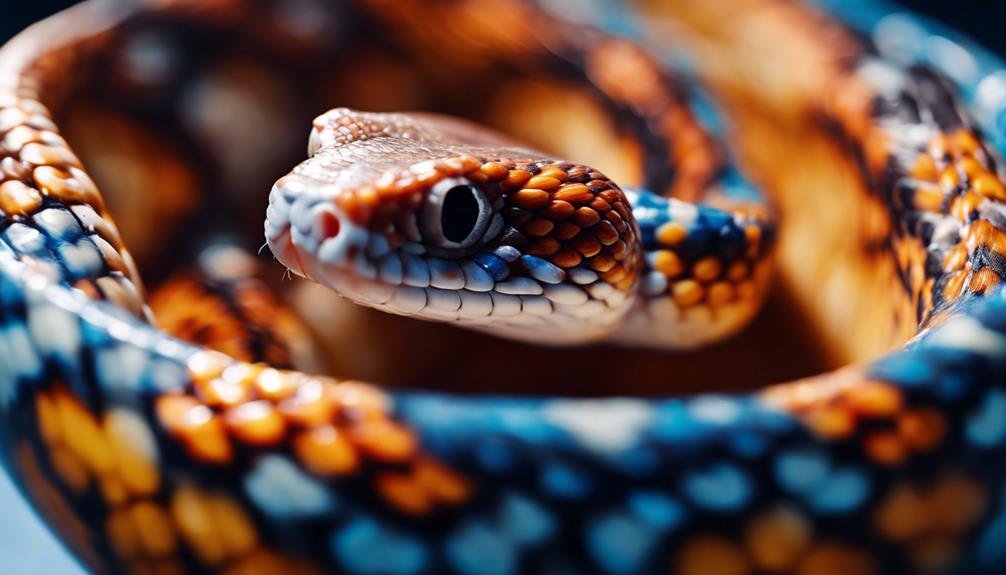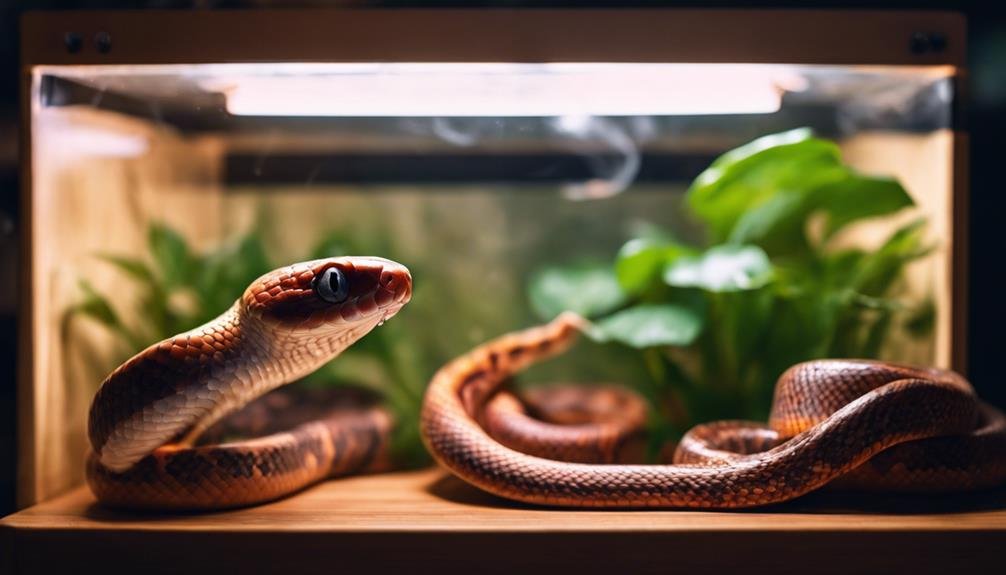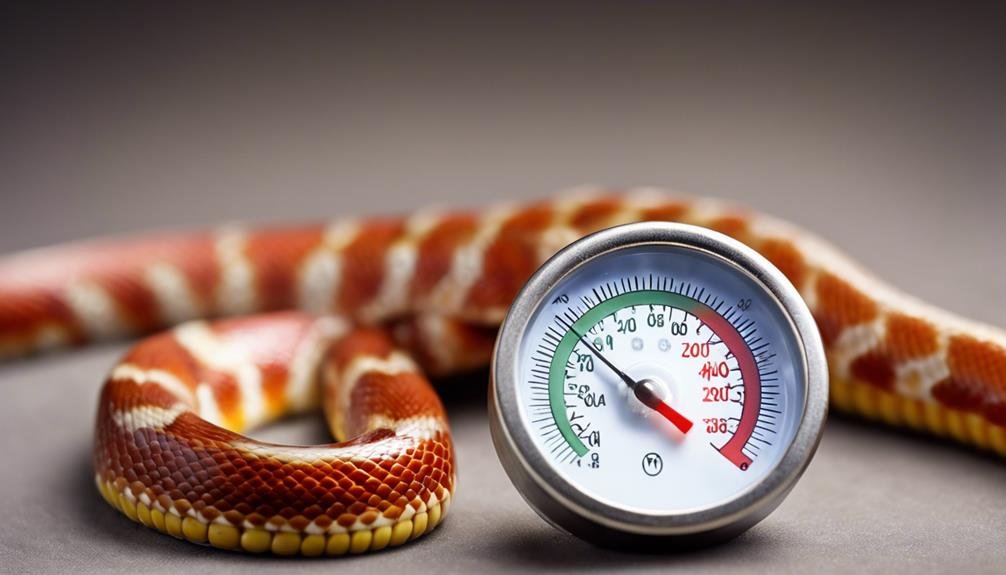You might wonder if your corn snake can manage without a heat source, considering they're such resilient creatures. However, as ectothermic animals, they depend on external warmth to regulate their body temperature. This is not just about essential; it's vital for their digestion. Without adequate heat, they struggle to process food, which can lead to significant health issues. Think about the implications of inadequate heating on their well-being and how creating an ideal environment is not just beneficial but necessary. What happens to a corn snake when it's left in a cool environment for too long? Let's explore the importance of heat for these fascinating reptiles and how it affects their overall health and digestive system.
Key Takeaways
- Corn snakes cannot properly digest food without adequate heat, leading to health complications.
- Lack of heat disrupts their metabolism, affecting their overall well-being and energy levels.
- Inadequate heating can cause digestive distress, including regurgitation and slowed digestion.
- Proper cage temperatures (80°F – 85°F) are crucial for their comfort and efficient digestion.
- Consistently cool environments increase susceptibility to infections and respiratory issues in corn snakes.
Understanding Corn Snake Biology
Corn snakes often depend on external heat sources to regulate their metabolism and digestion, an essential aspect of their biology. As ectothermic creatures, they don't produce their own body heat, so they rely on the environment to manage their body temperature. You've got to make sure they've access to proper cage temperatures, ideally between 80°F – 85°F (26.7°C – 29.4°C), to maintain their health and facilitate the digestion process. Without this important heat, they struggle to digest food properly, which can lead to significant health issues.
Inadequate temperature control in their habitat isn't something you want to overlook. It's not just about keeping them warm; it's about providing a condition necessary for their survival. If a corn snake's environment is too cool, its metabolism slows down, which directly impacts its ability to digest food efficiently. This can result in digestive problems that aren't only uncomfortable for the snake but can also lead to more severe health complications over time. So, when you're setting up their space, remember, managing heat isn't just for their comfort—it's crucial for their well-being.
The Role of Heat in Digestion
You might wonder how heat influences your corn snake's ability to digest its meals.
Heat plays a vital role in ensuring the digestive enzymes function properly, affecting the snake's overall metabolism and health.
Without adequate warmth, your snake's digestion can slow, leading to potential health problems.
Heat's Digestive Functions
Understanding the role of heat in digestion reveals why it's essential for corn snakes to have a warm environment to efficiently process their meals. Heat is important for their digestive functions, facilitating the breakdown and processing of food. This warmth directly influences their metabolism, ensuring they can digest their meals properly. Without adequate heat levels, a corn snake's digestive system may falter, leading to issues such as food regurgitation or slow digestion, which can impact their overall health.
Therefore, maintaining proper cage temperatures isn't just about comfort; it's an essential aspect of supporting their digestion. Ensuring your corn snake's habitat is warm enough guarantees that their metabolism and food digestion processes function optimally, preventing unnecessary health concerns.
Temperature Impact on Metabolism
Heat's role in the metabolism of corn snakes is crucial, as it directly impacts their ability to digest food efficiently. As ectothermic animals, their body temperature—and consequently their metabolism—depends on external heat sources. Without adequate warmth, their digestive system can't operate at full capacity.
Here are three key points to keep in mind:
- Temperature Regulates Metabolism: The right heat levels guarantee enzymes work effectively for food breakdown.
- Ectothermic Adaptation: Being ectothermic, corn snakes rely on environmental heat for metabolic processes, including digestion.
- Health Implications: Inadequate temperature not only slows digestion but can lead to nutritional deficiencies and health issues.
Understanding the importance of temperature for your corn snake's metabolism and digestion highlights why maintaining essential heat conditions is non-negotiable.
Cold Effects on Digestion
Given their reliance on external warmth, corn snakes suffer in cold conditions, as their digestion slows dramatically without sufficient heat. As ectothermic reptiles, they depend on the environment to regulate their body temperature and, consequently, their metabolism.
Without the ideal heat range of 80°F to 85°F, their ability to break down and absorb nutrients from their food is compromised. This can lead to significant health issues, such as regurgitation and malnutrition. It's important to maintain the right temperature in their habitat to prevent these digestive problems.
Creating a Suitable Environment
To guarantee your corn snake thrives, you'll need to maintain the enclosure's temperature within the ideal range of 80°F to 85°F.
Humidity control is also essential, as it supports their shedding process and overall health.
Optimal Temperature Range
Creating a suitable environment for your corn snake involves maintaining a favorable temperature range of 80°F – 85°F (26.7°C – 29.4°C) to guarantee their comfort and facilitate proper digestion. This ideal temperature range is essential for:
- Ensuring efficient digestion, so your snake can process its food without issues.
- Supporting metabolic functions that are important for your pet's overall health and well-being.
- Helping your corn snake thrive in captivity, maintaining its health and vigor.
Without the right temperature, your snake might face digestive problems, affecting its well-being negatively. By keeping the environment within this specific range, you're providing a foundation for your corn snake to live a healthy, content life under your care.
Humidity Control Essentials
Just as important as maintaining the right temperature, ensuring your corn snake's enclosure has humidity levels between 40-60% is essential to their health and successful shedding. To keep these levels ideal, you'll want to use a hygrometer. This device helps you monitor the humidity, so you can adjust as necessary, ensuring your snake can shed properly.
Inadequate humidity might cause your snake to retain eye caps or experience other shedding issues. To prevent this, consider misting the enclosure lightly or providing a moist hide. Remember, if the humidity drops too low, your corn snake could face dehydration or even respiratory problems. Keeping an eye on the humidity levels is vital for your pet's well-being.
Diet and Nutritional Needs


Understanding the diet and nutritional needs of corn snakes is essential for their health and longevity. As you explore the care of your corn snake, it's important to recognize how closely their diet, digestion, and overall well-being are tied to their environmental temperature. Heat isn't just a comfort; it's a necessity for these reptiles to metabolize their food correctly and maintain peak health.
Here are three key points to remember about the relationship between a corn snake's diet and temperature:
- Heat Aids Digestion: Corn snakes require proper heat to efficiently break down their food. Without adequate warmth, their digestive processes slow down significantly, leading to potential health issues.
- Temperature Range is Vital: Maintaining the correct temperature range within your corn snake's enclosure ensures they can extract essential nutrients from their diet. This supports their digestive system and overall well-being.
- Risk of Regurgitation: Inadequate heating can lead to digestive distress for corn snakes, including the inability to properly digest meals. This might result in regurgitation, which isn't only stressful for your snake but can also impact its health over time.
Symptoms of Inadequate Heating
Recognizing the symptoms of inadequate heating in corn snakes is essential for their health and well-being. Without the proper warmth, their digestive functions slow down, leading to a cascade of health issues. If you notice your corn snake exhibiting decreased appetite, it could be a sign that the temperature in their habitat is too low. Sluggish behavior is another indicator; a corn snake that's less active than usual might be struggling to maintain its body temperature.
Inadequate heating doesn't just affect their activity levels and appetite. It can also lead to improper shedding, which is stressful and potentially harmful to your snake. The skin that doesn't fully shed can constrict blood flow to the area it covers, leading to serious health problems.
Furthermore, a consistently cool environment makes corn snakes more susceptible to infections and respiratory issues. These conditions can rapidly deteriorate their health, leading to severe consequences if not addressed promptly.
| Symptom | Cause | Effect |
|---|---|---|
| Decreased Appetite | Inadequate Heating | Poor Digestion |
| Sluggish Behavior | Low Temperature | Lowered Metabolism |
| Improper Shedding | Cool Environment | Potential for Infections |
Ensuring your corn snake has adequate heating is vital to prevent these symptoms and promote a healthy, active life.
Will Using Sand as Substrate Affect the Comfort and Digestive System of Corn Snakes?
Using sand as substrate for corn snakes can negatively impact their comfort and digestive system. The abrasive texture of sand can cause skin irritation and injury to the snake’s digestive system if ingested. It’s best to opt for substrate alternatives such as aspen shavings or paper towels for the well-being of corn snakes.
Alternatives to Traditional Heating


Given the importance of proper heating for your corn snake's well-being, exploring alternative heating methods can offer safer and more efficient solutions. Traditional heating lamps might provide warmth, but they can also pose risks and may not evenly distribute heat. Here's where alternative heating methods shine, especially for the unique needs of your corn snake.
Consider these three alternative heating methods:
- Under Tank Heating Mats: These mats provide a consistent heat source from beneath the enclosure, simulating the natural warmth your corn snake would seek from the ground. They're excellent for maintaining the required temperatures of 80°F – 85°F, essential for your snake's digestion and metabolism.
- Heat Mat with Thermostat Control: A step up from basic under tank heating mats, these come with thermostat controls allowing you to precisely manage the temperature. This maintains the enclosure never gets too hot or too cold, providing your corn snake with the ideal external warmth needed for their well-being.
- Radiant Heat Panels: Installed inside the enclosure, these panels emit infrared heat, creating a comfortable environment without the risk of burns. Radiant heat panels are especially beneficial for larger enclosures, offering a more evenly distributed heat source.
Monitoring and Maintaining Health
To maintain your corn snake's health and vitality, it is crucial to monitor and maintain the enclosure's temperature meticulously. Corn snakes are ectothermic, relying on external temperatures for vital metabolic processes, including digestion. Without adequate heat, your snake may face significant health problems due to disrupted digestion.
Monitoring cage temperatures ensures that your pet's environment supports its well-being. Regular checks help prevent the adverse effects of temperature fluctuations on your snake's health. Here's a simple guide to assist in maintaining the right conditions:
| Aspect | Ideal Condition | Importance |
|---|---|---|
| External Temperatures | Warm gradient (75°F-85°F) | Supports efficient digestion |
| Digestion | Supported by proper heat | Prevents digestive issues |
| Health Problems | Minimized with stable heat | Maintains overall vitality |
| Metabolic Processes | Optimal at correct temperatures | Supports growth and health |
| Cage Temperatures | Regularly monitored | Guarantees a suitable habitat |
Conclusion
So, you've learned that corn snakes really can't live without heat. It's not just about their comfort; it's essential for their digestion and overall health.
By providing the right warmth, you're ensuring they can process their food properly and thrive. If you notice any signs of distress or digestive issues, it might be time to reevaluate their heating setup.
Remember, creating a warm, inviting environment isn't just a nice-to-do, it's a must-do for your corn snake's well-being.



[…] pythons, like corn snakes and heat requirements, require specific temperature ranges for their health and shedding. Inadequate heat can lead to […]